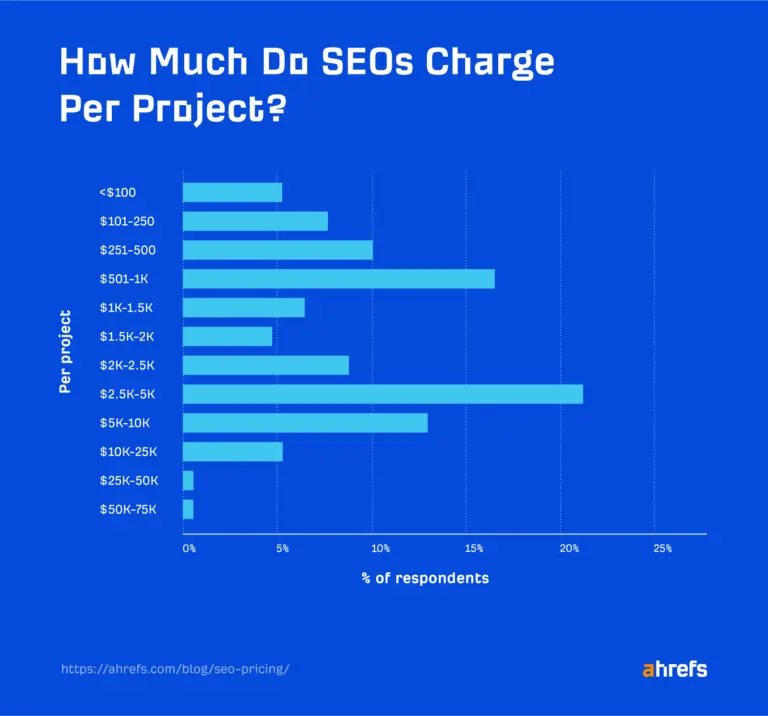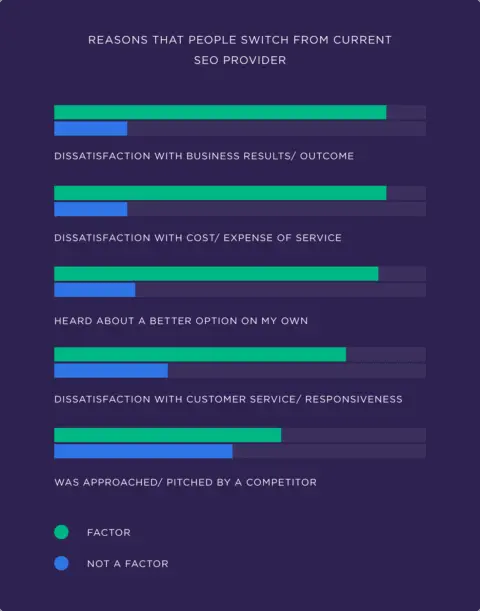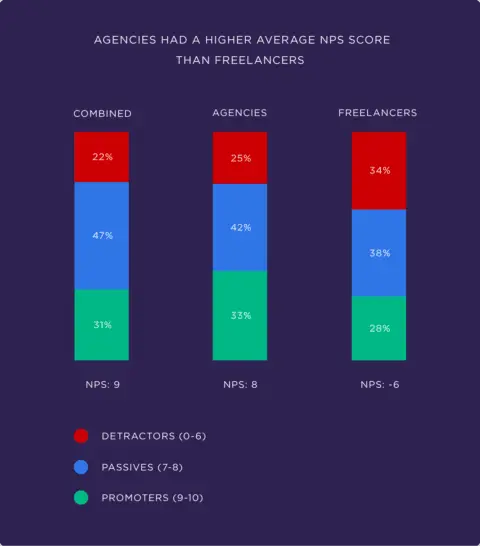Search engine optimization (SEO) is an integral part of digital marketing strategies for businesses. It helps website owners increase their online visibility and drive more organic traffic to their websites.
Technically, SEO is free. You just have to make sure your website follows the best practices set by a search engine, and you're good to go. However, it's easier said than done.
As of February 2023, there are 200 million websites active online. That's a lot of competition.
If you want to make your way through this competitor pool, you'll have to invest in SEO marketing. How? By hiring SEO marketing agencies to do the job for you.
But how much does it cost? Let's discuss.
What Does an SEO Marketing Agency Do?
Before we go on to explain SEO pricing models, let's look at what SEO marketing agencies do. They:
- Conduct keyword research
- Optimize website structure and content
- Manage backlinks
- Track website performance and make necessary adjustments
- Write and publish content for websites and social media
- Conduct competitor analysis
- Provide SEO consultations and reports
SEO marketing agencies basically work on three domains of SEO: on-page, off-page, and technical. While on-page SEO focuses on optimizing individual web pages, off-page SEO involves building backlinks and promoting a website through external channels.
Technical SEO encompasses the technical aspects of a website such as site speed and mobile friendliness. Voice SEO is also emerging as a new domain now. Statista data shows that 142 million Americans, half of the country's population, were using voice assistants in 2022. The figure is expected to go up to 157.1 million by 2026.
More and more SEO marketing agencies are now offering voice search optimization services alongside traditional SEO strategies.
What Is an SEO Marketing Agency Pricing Model?
The pricing ''model'' is the framework that an SEO marketing agency uses to determine the cost of their services. It may be based on performance outcomes, hourly rates, or other factors.
The kind of model you select determines what you pay for. For example, if you opt for performance-based pricing, your campaign's success will decide the total cost of the services. Similarly, if you choose hourly pricing, you pay for the number of hours the agency spends on your project, irrespective of the results.
There's no one-fits-all approach in this regard. Some pricing models are more suitable for certain business types, while others may be better for different industries. It also depends on the goals of your SEO campaign.
7 SEO Marketing Agencies Pricing Models
SEO marketing agencies use many different pricing models. Here are some of the most common ones.
1. Hourly Rates
Best For: Small projects, one-time services
Hourly rates are the most straightforward pricing model. The agency charges a specific rate per hour for its SEO services. According to a Credo report, 85.49% of SEO agencies charge anywhere from $50 to $200 per hour. The common per hour range is between $100 and $200.
Ahrefs also found similar results in its study. According to an Ahrefs study, 24% of SEO agencies charge $75 to $100 per hour.

Per hour pricing for SEO agencies
As per this model, the client pays for the total number of hours spent on their project. If the project takes longer to complete, the client pays a higher cost for the services.
The SEO services which the agency will provide during these hours depend on the project's scope and requirements. Such a model works best for small projects with specific deliverables, such as a website audit or keyword research.
Pros: An hourly model is highly transparent, because you know what you're paying for. It's also flexible since you can use it for larger or smaller projects. Also, the pricing is straightforward and doesn't depend on the results of the campaign.
Cons: In a long-term project, it's hard to be certain about the total amount you'd have to pay. You're also charged an ''efficiency penalty,'' which basically means that the agency might deliberately take longer to complete tasks to increase their revenue.
Hourly Pricing: SEO Agencies vs. Freelancers
An SEO marketing agency charges more per hour compared to a solo freelancer. Ahrefs' report found that while agencies charge around $100 per hour, freelancers charge $71.59 on average for the same hour. The costs may be even lower if you hire SEO professionals from a freelancing site like Upwork.

Per hour rates for SEO experts on Upwork
On the other hand, consultancies are costlier, charging $171.18 per hour on average. The difference in pricing is justified by the level of expertise and resources these agencies and consultancies offer.
2. Project-Based Pricing
Best For: Projects with clear timelines and deliverables
SEO isn't a one-time thing. It's something you do regularly. So, it's best to divide SEO efforts into smaller projects. Some examples of SEO projects are:
- SEO audits
- Keyword research
- Link building
- Content creation
In a project-based pricing model, you pay the SEO agency for the project rather than for hours. The pricing is determined beforehand based on project length and scope.
For instance, Third and Grove requires you to explain the scope of your SEO project. They then give you a price based on your requirements.

Third and Grove contact form
According to Ahrefs, 48.9% of SEO agencies charge a per-project fee for their services. On average, the cost for a project ranges between $2,501 and $5,000.

How much do SEOs charge per project
Pros: The main upside of project-based pricing is that you know the total cost of a project beforehand. It's easier to budget for SEO efforts and avoid nasty surprises later.
Cons: If an additional service comes up, the contract needs to be renegotiated. There's also a risk of paying more for less work if the agency overestimates the project's complexity.
3. Monthly Retainer Pricing
Best For: Ongoing SEO efforts
A monthly retainer pricing model is possibly the most common payment structure for SEO services. It's when a client agrees to pay a fixed amount every month.
Most SEO agencies have different plans or tiers based on the services included. Clients can choose a plan that suits their needs and budget.

WebFx monthly retainer pricing model
Suppose an SEO agency has three tiers: Bronze, Silver, and Gold. The Bronze tier is $500 per month and includes keyword research and content optimization.
Similarly, the Silver tier may be $1000 per month and includes everything in the Bronze tier plus link building. The Gold tier would be the most expensive of the three, coming at $2,000 a month. It may include all the services in the Silver tier plus additional SEO audits and analytics tracking.
Usually, such agencies also have custom packages where clients can choose specific services they need. They quote you a price based on the services you select. Then, you pay that amount every month.
Pros: Retainer-based SEO pricing models are for long-term gains. They also build a strong relationship between the agency and the client.
Cons: They require a certain level of trust between the client and the agency. The client may have no guarantee of results and may have to pay for services they don't need. There's also the risk of getting locked into a long-term contract without seeing significant results.
4. Performance-Based Pricing
Best For: Easily measurable results
Performance-based pricing is exactly how it sounds. The SEO agency ties the cost of their services to the performance and results they deliver. Clients only have to pay for results.
For example, an agency may charge $500 for every keyword that reaches the top 10 search results or a percentage of sales generated through their SEO efforts.
Performance-based pricing model is ideal for metrics that you can measure easily. Take the example of PPC advertising. The agency can charge a percentage of the ad spend or a flat fee for every click generated.
Pros: Clients can expect the agency to deliver the best results as they are incentivized to do so. The risk and reward are shared between both parties. Clients also have more control over what they pay for and don't have to pay for services that don't generate results.
Cons: There might be an increased focus on quick-wins. The agency may also prioritize certain tasks over others to achieve results faster, which can result in a lower quality of work.
5. Value-Based Pricing
Best For: Clients who prioritize ROI
The ''value'' in value-based pricing refers to the impact SEO services have on a client's business goals. Some indicators of value include:
- Increased website traffic
- Higher search engine rankings
- More conversions and sales
- Improvements in brand awareness and online reputation
- Higher customer lifetime value
The agency determines a price based on the client's perceived value of its services. For instance, if an SEO campaign is projected to generate $10,000 in additional monthly revenue for a client, the agency may charge a percentage of that amount as their fee.
The difference between performance-based and value-based pricing is that the latter does not solely rely on tangible results. It also accounts for the intangible benefits of SEO services.
For example, higher search engine rankings may not immediately result in increased revenue, but they can lead to a stronger online presence and improved brand reputation. So, it's a service the client would pay for in a value-based pricing model.
Pros: Like performance-based pricing, the agency is dedicated to delivering value and not merely checking the SEO checklist boxes.
Cons: The concept of ''value'' is subjective. It can result in disagreements between both parties.
Case Study: HawkSEM is an example of an SEO agency that doesn’t rely on contracts. Instead, the agency determines SEO costs based on results. Other factors that come into play are the client’s goals, timeline, account size, and competition.

HawkSEM SEO pricing
Output-Based Pricing
Best For: Specific SEO deliverables
An output-based pricing model bases the cost of SEO services on the ''outputs'' of the project. These deliverables may be a website redesign or content creation.
Usually, there is a set price for each deliverable. For example, an agency may create a blog post for $200 and an Instagram Reel for $400. If you require ten blog posts and five Instagram Reels, this agency will charge you $4000 for the entire project.
Output-based pricing suits clients who have a clear idea of their needs and are not looking for ongoing SEO services. It also works well for agencies specializing in specific SEO deliverables rather than providing comprehensive services.
Pros: The client knows the upfront cost. Both parties also clearly understand the expected deliverables.
Cons: The agency is not incentivized to go above and beyond in its services.
Case Study: Goodie Website, a web development company in Europe, hired SEO Plus, for specific SEO-related outputs. These included 100 leads, 20 to 25 web design projects, and 10,000 website visitors per month. Such a campaign is based on pre-specified outputs. So, the SEO agency only focuses on those metrics rather than comprehensive SEO servicing. SEO Plus helped boost the company’s organic website traffic by 393% and leads by 1050%.
Mixed Rates
Best For: Comprehensive SEO services
Mixed rate pricing models are a blend of different pricing structures. Such a model may have a monthly retainer fee or a fixed project-based pricing. Then, there may be additional costs for extra deliverables, such as creating a social media campaign or optimizing for local SEO. A performance bonus may also be included in the contract.
Clients who plan to work with an agency for a long time should consider this pricing plan. It is rigid enough to maintain a relationship but also flexible enough to accommodate the changing needs of a business.
Pros: The agency can change its pricing model for every client. Clients know upfront how much they'll have to pay.
Cons: As more services pile on, the billing process may become complicated.
Case Study: HawkSEM’s example that we gave earlier also fits here. The agency has a general monthly pricing. Additional costs depend on the client’s timeline, goals, and account size.

HawkSEM SEO pricing
Payment Methods for SEO Services
Now that you know the SEO marketing pricing models, let's look at payment methods.
Upfront Payment
The client pays upfront, i.e., even before the project starts. Upfront payment is typically a good option for agencies and clients that already have a solid relationship. Newer clients are often hesitant to pay the full amount upfront.
Payment Upon Completion
Some agencies bill clients after they have finished the project. For example, a client may approach an SEO agency for its local SEO. The client wants to appear on the first page of Google search results and get 500 calls a month.
Once the agency delivers these results, the client pays the total amount agreed upon.
Half-and-Half Payment
It's a mix of the above two methods. The client pays half of the total amount upfront and the remaining half upon completion of the project. It allows for some security for both parties involved.
Recurring Payments
Monthly retainers fall under this category. The client pays the agency a fixed amount every month for ongoing SEO services. These payments are typically made through automatic bank transfers or credit card payments.
Staged Payments
An agency may break down the project into stages and bill the client for each stage completed. Suppose an agency is providing SEO services to a client that has a website with 100 pages. The payment structure could be as such:
- 25% payment upfront
- 25% after optimizing 50 pages
- 25% after optimizing 80 pages
- 25% upon project completion
Staged payments also help both parties. The client doesn't have to pay the full amount upfront, and the agency receives a steady inflow of money to keep operations going smoothly.
Which SEO Marketing Pricing Model Is the Best?
There's no such thing as a singular ''best'' pricing model. The best will differ for each organization and budget.
SEO Pricing Model | Suitable For | Example Use Case |
Monthly Retainer | Ongoing SEO services | A medium-sized apparel business wanting to grow its online presence, organic traffic, search engine rankings, and revenue |
Hourly Pricing | Smaller projects | A small business looking for a technical SEO revamp |
Project-Based | One-time SEO needs | A business hiring an SEO agency to create content for its holiday season campaigns |
Performance-Based | Measurable/tangible results | A business looking to get results for its PPC advertising |
For example, SMEs or enterprises may opt for a monthly retainer pricing model to get regular SEO services. On the other hand, a smaller company that only needs a specific project to be done, such as local SEO, can go for project-based or hourly pricing.
It's up to you to decide which pricing model will work best for you. Consider your budget and SEO needs when making this decision.
If your SEO needs are only for the time being, you don't need to get into long-term contracts for monthly retainers. Simply pay for a one-time project. Do the same if you have a limited budget and you cannot afford to spend over $1,000 on SEO every month.
However, if you're the kind of business that thrives off of online presence, such as an e-commerce retail store, you'll need a monthly retainer to keep your website optimized.
Keep in mind that a pricing model is not set in stone. You can always discuss and negotiate with the agency for a customized digital marketing package that fits your specific needs and budget.
A Backlinko study found that 81% of clients switch from their current SEO providers due to dissatisfaction with costs. If you’re not comfortable with an agency’s pricing, you can always search for another provider that offers a more suitable pricing model.

Reasons clients switch from current SEO providers
How to Set a Budget for SEO
As mentioned, the kind of SEO pricing you choose will depend on your budget. Here's how to set a realistic budget for your SEO needs.
Step 1: Review Budget Allocations
If you're a large enterprise, you may have a separate budget to invest in your SEO strategies or to hire an enterprise SEO agency. However, for most SMEs, SEO falls in the marketing category.
So, start with a review of your marketing budget. How much of it is currently allocated to SEO?
Step 2: Determine Your Requirements
Outline your SEO-related needs. Instead of going for general requirements, highlight your periodic needs. For example, you can divide SEO requirements into quarterly or annual.
Let's say in the first quarter, you need website optimization and keyword research. In the second quarter, you want to focus on link building and content creation. It goes on.
Step 3: Evaluate Current SEO
Run an audit of your current SEO. Some elements might already be working fine and just need tweaking, while others may require a complete overhaul.
Step 4: Determine the Budget
Suppose, after the audit, you found that your online presence lacks most in content creation and link building. Now, how much would these services cost?
You can reach out to multiple providers for quotes and decide on a cost. Similarly, if you're building your SEO from scratch, a monthly retainer might work best.
Step 5: Keep Room for Changes
With SEO, you can never be sure of the exact amount you'll end up spending. Keep a small buffer in your budget for additional costs.
Is It Worth Paying SEO Agencies for Their Services?
In most cases, yes. SEO services might come off as expensive, but it's only because you're getting a bunch of different services all together. Plus, the agency is providing you with years of expertise and knowledge that would cost you a lot more to accumulate yourself.
If you were to hire in-house SEO specialists, you would need to pay their salary, benefits, bonuses, and additional costs like training or certifications. All of these costs can add on. On the other hand, SEO agencies cost much less.
Also, they tend to offer better results than freelancers. Backlinko's study found that agencies have a higher Net Promoter Score (NPS) than freelancers, indicating higher customer satisfaction.

NPS scores for agencies vs. freelancers
Conclusion
When hiring an SEO agency, their pricing model is an important determinator in a client’s choice. Some common SEO marketing pricing models include monthly retainers, performance-based pricing, project-based pricing, hourly rates, and value-based pricing.
The type of pricing model a client chooses depends on their budget and SEO needs. Many agencies also offer mixed rates in which clients pay a recurring monthly amount while extra services are charged additionally.
It’s imperative to select the right SEO pricing model to ensure you get the most value for your money. SEO is a long-term investment; you won’t see results immediately. Choosing a reputable agency and patience are key in this regard.




